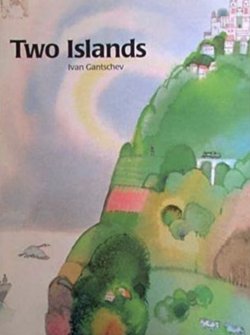Gareth B. Matthews

Review of Two Islands by Ivan Gantschev (Natic, MA: Picturebook Studio USA, 1985). Originally published in Thinking: The Journal of Philosophy for Children 7(4): 1.
This is the story of two islands in the middle of the ocean, Greenel and Craynel. The first settlers on Greenel found it to be green and fertile. Their leaders reasoned, “Since our island is only so big and no bigger, we will have to tend it and keep it as lovely as it is to day.” and they did.
The first settlers on Graynel also found their island to the green and fertile. But their leaders reasoned, “Since our island is only so big and no bigger, we will have to work very hard to keep up with the rest of the world:” And they did.
Soon Craynel was covered with factories, skyscrapers and traffic lights. The inhabitants elected Gordon D. Warden to be the Boss. He promised to make their island the richest and busiest and most famous island in all the world. And he did. When roads, factories and skyscrapers squeezed out even the tiniest parks on Craynel, the people demanded vacation land. Gordon D. Warden got a great idea. He went to Greenel and offered to build, at no expense to Greenel, a bridge in fact, the world’s longest bridge to connect the two islands. Unappreciatively, the President of Greenel refused the offer. He reasoned, “Before long, our island would be just like Craynel; but we want to keep Greenel as it is:”
Gordon D. Warden was furious. He decided to build the bridge anyway. Many citizens of Graynel thought it was wrong to build a bridge to Greenel if the citizens of that island did not want the bridge. They carried signs and protested. But they were declared traitors and they were deported. Some of them went to Greenel and settled there.
Gordon D. Warden began stockpiling wire and steel and rock and cement-for the bridge he was determined to build. But just when the people of Graynel had assembled to witness the beginning of the construction of the bridge, the whole is land tipped upon its edge and slid down into the oily water of Warden Bay. Gordon B. Warden himself plus all the heavy building materials, the weapons he had assembled to back up his project, and all the people and their cars and factories, slipped down into the bottom of the sea.
The moral of this story is obvious enough. Overarching human ambition, without regard to nature’s limitations, brings self-destruction. The good guys who know their place in the natural world and respect the environment live happily ever after. The bad guys-those with overweening ambition and no respect for nature-slip to the bottom of the sea.
It is worth reminding ourselves that children who read this book, or who have it read to them, are much more likely to live in a city than in the country. For them Greenel will be almost as fanciful and remote as it was to the inhabitants of Craynel. Graynel will be much more like the world they actually inhabit. Are they to think that their world, too, will slip one day into the sea?
Unlike children’s literature that is meant to socialize children and train them to take their preordained places in society, this book is aimed at encouraging child ren to be social critics. The author clearly hopes to encourage them to do a better job at running their society than their parents and teachers have done.
Are young children even children of “picture-book age” capable of social criticism? Or will a book like this so undermine their sense of well-being and their belief in the rationality and beneficience of the world around them that their psychological and emotional development will be impaired?
Of course, children, even very young children, can and should be encouraged to be social critics. But if we don’t want them to be either phobic or cynical, we had better take the occasion reading a book like this presents to reflect with them on the issues the story raises.
Certainly, Craynel was overdeveloped. It was, in fact, a caricature of a modern industrial and urban society. But couldn’t Gordon D. Warden have scaled down his ambitions somewhat? Couldn’t he, in fact, have developed a reasonable alternative to pastoral Greenel? Or does the road to modernization lead only to self-destruction?
Certainly, some people prefer to live in Vermont. But some people prefer to live in New York City, even with all the problems New York City has. For them Greenel might be a nice place to visit, or even to retire to; but they wouldn’t want to live there now. So what could they do to make Craynel more livable, or just to keep it from sliding into the sea?
And what about minority rights within a society? Suppose the bridge protestors on Graynel had not been branded traitors and deported; suppose they had simply been voted down? Would the majority have had any obligation to limit or modify their policy in respect for the minority?
And what about Greenel’s obligations to the rest of the world, and to Crayne) in particular? After all, both islands were on “Island, Earth:” How can one resolve a basic dispute of this sort between two islands? Or between two countries?
Two Islands is a modern fable, beautifully told and wonderfully illustrated. As an ideological tract it could certainly be effective. But I nurture the hope it might be used for a higher purpose. It could be used to open a real conversation, with our children, about how we should organize our lives and set our social goals in the many island-societies that make up this earth. That conversation could be as useful for us, as it would be for our children.
